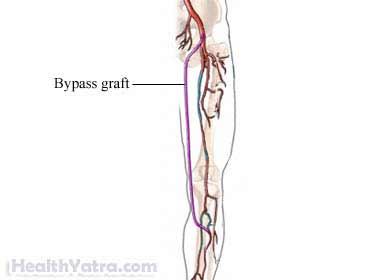সংজ্ঞা
In this surgery, the patient’s vein or an artificial tube is used to create a bypass around a blocked main leg artery. The blocked arteries in the legs are usually caused by a buildup of plaque. When this buildup occurs, it is called peripheral arterial disease (PAD).

পদ্ধতির কারণ
- To restore proper blood supply to your lower leg
- To relieve leg pain caused by a blocked artery
- To prevent the need for amputation
সম্ভাব্য জটিলতা
If you are planning to have femoropopliteal bypass surgery, your doctor will review a list of possible complications, which may include:
- রক্তপাত
- Blood clots (eg, clots that causes blockage of bypass graft)
- সংক্রমণ
- Adverse reaction to the anesthesia
- Organ damage
- Need for limb amputation
- Heart attack or death
পদ্ধতির আগে আপনার ডাক্তারের সাথে এই ঝুঁকিগুলি নিয়ে আলোচনা করতে ভুলবেন না।
কি আশা করা যায়
পদ্ধতির আগে
আপনার ডাক্তার সম্ভবত নিম্নলিখিতগুলি করবেন:
- রক্ত পরীক্ষা
- Electrocardiogram (ECG, EKG)—a test that records the heart’s activity by measuring electrical currents through the heart muscle
- Chest x-ray —a test that uses radiation to take pictures of structures inside the body
- Ultrasound—a test that uses soundwaves to make an image
Leading up to the surgery:
- আপনার ওষুধ সম্পর্কে আপনার ডাক্তারের সাথে কথা বলুন। পদ্ধতির এক সপ্তাহ আগে আপনাকে কিছু ওষুধ খাওয়া বন্ধ করতে বলা হতে পারে, যেমন:
- প্রদাহ বিরোধী ওষুধ (যেমন, অ্যাসপিরিন)
- Blood thinners, like clopidogrel (Plavix) or warfarin (Coumadin)
- If advised by your doctor, take antibiotics to prevent an infection.
- Arrange for help at home after the surgery.
- The night before the surgery, have a light dinner. Do not eat or drink anything after midnight.
এনেস্থেশিয়া
You may be given:
- General anesthesia (almost always used)—blocks pain and keeps you asleep through the surgery
- Spinal anesthesia —the area from the chest down to the legs is numbed; given as an injection in the back
পদ্ধতির বর্ণনা
The doctor will make a cut in the skin on the leg. Through this cut, the doctor will take out a vein that will be used to make the bypass. If the vein cannot be used, then an artificial vein is used.
Next, an incision will be made in the groin to expose the femoral artery. This is the artery in the thigh. The doctor will make another incision at the back of the knee to expose another artery. This is called the popliteal artery.
The doctor will use clamps to block the flow of blood through these two arteries. One end of the new bypass vein will be stitched into the femoral artery, and the other end will be stitched into the popliteal artery. Once attached, blood will be passed through the graft to check for leaks. If leaks are found, the doctor will repair them. The clamps will then be removed. This will allow blood to flow through the graft to the lower leg. The doctor will use stitches to close the incisions.
In some cases, a vein in the thigh will be used as a graft while left in place. This is called in situ. In this procedure, the valves inside the vein will be removed with a small scope and a small cutting tool. The vein will then be attached to the arteries to form a graft.
অবিলম্বে প্রক্রিয়া পরে
- For the first 24-48 hours, fluids and pain medicines may be given by IV.
- You may need to wear an oxygen mask for the first 10-12 hours.
- An epidural in your back (to numb the site and relieve pain) may be left in place for the first 3-5 days. Once this is removed, your doctor will give you pain medicine.
কতক্ষণ এটা লাগবে?
1-3 hours
এটা কতটা আঘাত করবে?
As you heal and the swelling in your leg subsides, you may have pain for weeks or even months. Ask your doctor about medicine to help with the pain. Keep in mind that it is normal for your leg to remain swollen for 2-3 months.
গড় হাসপাতালে থাকার
7-10 days
পোস্ট-প্রক্রিয়া যত্ন
হাসপাতালে
While you are recovering at the hospital, you may be instructed to:
- For the first 1-2 days, use cold packs to decrease pain and swelling. A nurse will apply a cold pack to the area for 15-20 minutes each time.
- You may wear boots or special socks to help prevent blood clots
- You may be asked to use an incentive spirometer, to breathe deeply, and to cough frequently. This will improve lung function.
- Your incision will be examined often for signs of infection.
ঘরে
আপনি যখন বাড়িতে ফিরে আসবেন, একটি মসৃণ পুনরুদ্ধার নিশ্চিত করতে নিম্নলিখিতগুলি করুন:
- Do not drive for 4-6 weeks, or until you are pain free.
- If advised by your doctor, walk every day. Walking will make your legs stronger. Slowly increase how far you walk.
- Work with a physical therapist.
- Slowly increase the activity you do each day.
- When sitting, keep your legs elevated.
- Place a pillow under your leg when sleeping.
- কখন গোসল করা, গোসল করা বা জলে ভিজানো নিরাপদ সে সম্পর্কে আপনার ডাক্তারকে জিজ্ঞাসা করুন।
- Keep the wound dry. Avoid using talc or powder.
- Avoid fatty foods.
- Do not smoke. Smoking can interfere with healing.
- আপনার ডাক্তারের নির্দেশাবলী অনুসরণ করতে ভুলবেন না।
আপনার ডাক্তারকে কল করুন
- জ্বর এবং ঠাণ্ডা সহ সংক্রমণের লক্ষণ
- Severe pain in the leg
- আপনার পা ঠাণ্ডা, ফ্যাকাশে, নীল, ঝলমলে, বা অসাড় হয়ে যায়
- লালভাব, ফোলাভাব, ক্রমবর্ধমান ব্যথা, অত্যধিক রক্তপাত, বা ছেদ স্থান থেকে কোনো স্রাব
- Nausea, vomiting, or constipation
- ব্যথা যা আপনি ওষুধ দিয়ে নিয়ন্ত্রণ করতে পারবেন না
- কাশি, শ্বাসকষ্ট বা বুকে ব্যথা
- মাথা ঘোরা বা দুর্বলতা
- আপনার পা, বাছুর বা পায়ে ব্যথা এবং/অথবা ফোলা
- ব্যথা, জ্বলন, জরুরী, প্রস্রাবের ফ্রিকোয়েন্সি, বা প্রস্রাবে অবিরাম রক্তপাত
- নতুন, ব্যাখ্যাতীত উপসর্গ
জরুরী পরিস্থিতিতে, অবিলম্বে চিকিৎসা সহায়তার জন্য কল করুন।
